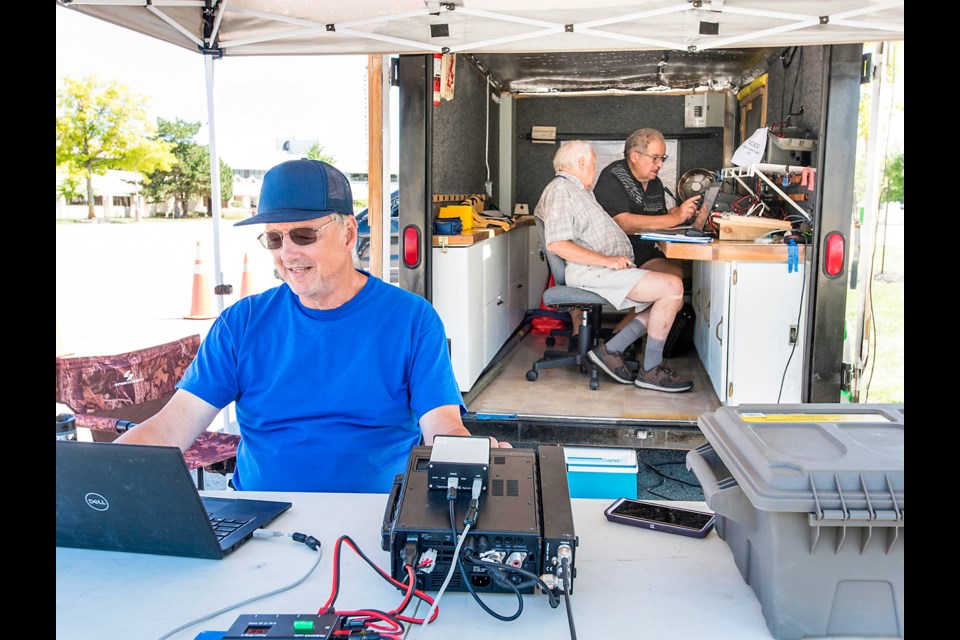Flash back to September 1, 2001, when terrorists attacked the World Trade Centre in New York City. When the towers fell, cell phones and landlines in the vicinity also went down. So how did critical information get out?
It was amateur radio operators, using relatively low-tech equipment, who made sure the police, fire departments, and other emergency services maintained communications.
“As long as the power grid is operational, cell phones and GPS are great. But when electrical power fails, we can literally be life-savers,” said Ken Gansel, president of the Niagara Peninsula Amateur Radio Club (NPARC).
A NOTL resident, Gansel, 74, is a retired chair of the Niagara Regional Police Service Board, who spent 44 years in the police justice sector, and has been an avid radio enthusiast since he was a teenager.
“When a natural disaster strikes or an emergency takes place, we can assist either from a mobile or a fixed base. We train to do this,” he said.
Amateur telemetry (known colloquially as HAM radio) involves the use of the radio frequency spectrum for the exchange of messages and emergency communications. It is classified as non-commercial, to distinguish it from for-profit radio broadcast stations, as well as police and fire, maritime, aviation, and taxi use. Each operator is licensed by the government, and has a unique identifying call sign, which must be used in all transmissions. It is estimated that some two million people throughout the world are regularly involved with amateur radio.
“HAM” is not an acronym. It was originally used as a pejorative term to mock operators who transmitted poor Morse Code over the radio in the early twentieth century (the insinuation being that they were “ham-fisted.”) For decades now, the amateur radio community has reclaimed the word as a label of pride.
Amateur radio has traditionally been associated with hobbyists, but in fact HAM users have made significant contributions to science, engineering, and industry over the years, and have saved lives in times of emergency. HAM radio also has applications in the classroom to teach a variety of subject areas.
Founded in in 1948, NPARC is active throughout Niagara, providing support for a variety of community events.
“We had thousands of amateur radio operators from all over the world who connected to the Canada Summer Games in Niagara last summer,” Gansel said. “We set up a portable station in the parking lot with an antenna.”
The beauty of amateur radio is that it can operate off a simple piece of wire, with a specific length tied to a specific frequency.
“Most amateurs will be on a set frequency during the daylight hours, and a different frequency during nighttime, because solar radiation on the ionosphere changes,” Gansel said. “During daytime, when it heats up, the ionosphere is pushed downward. Imagine a triangle. You send up a signal to the apex of the triangle, and then it goes back down the other side. At night when it's colder, the ionosphere is way up there, and your triangle length is drastically increased. What this means is that during the daytime, it's not unusual for me to make radio contact with HAM operators along the Atlantic seaboard and out into the Caribbean. At nighttime, to some extent you’ve got the potential to reach people around the world.”
NPARC is actively recruiting new members to its club, cognizant of the fact that a high percentage of its current members are over 50.
“It ebbs and flows,” Gansel said of club enrollment. “Traditionally, a lot of members joined after an experience in the Boy Scouts, where you could earn a merit badge for doing this stuff. It’s important to note that amateur radio is extremely social. It’s like an old-fashioned party line.”
But the emergency application of the hobby is still something members drill for at their meetings, ever wary that Vladimir Putin or Kim Jong-un could start lobbing nuclear missiles in our direction.
(This was an elemental plot point in the widely seen 1983 TV movie, The Day After, in which nuclear war breaks out between NATO and what was then the Warsaw Pact, leaving amateur radio operators around the world as the last remaining voices over the airwaves. It was the highest rated US television film in history, watched on its initial broadcast by 62 percent of Americans watching TV that night, a record it held until 2009.)
“We have an old surplus ambulance, which has been repurposed as a mobile command post,” said Gansel. “We've got radios hooked up, and a fancy Telus cellular modem on the roof, along with the capability of solar panels for power generation. Between the mobile unit and the stuff we have in our in own home radio rooms, we can basically respond anywhere in the region within 20 minutes. Emergency preparedness in Canada has been reactivated, with Bill Blair, the former Toronto police chief, in charge. The feds want to duplicate the American Homeland Security's emergency reactive force.”
In the event of a local emergency — perhaps a bad snowstorm in Fort Erie that downs power and communication lines — Gansel said that their mobile command truck would go to a central location, such as a fire hall in Fort Erie, and set up there.
“Most people, I think, are now aware that in an emergency, you go to the fire hall,” said Gansel.
NPARC meetings are held at the Black Creek Community Centre in Stevensville, the second Thursday of every month, at 7 PM. All are invited to come out and discover the allure of amateur radio. For more information, go to www.nparc.ca, or email to [email protected].
RELATED: Read about a Ridgeville HAM operator's experiences in this archived article from 1988.
